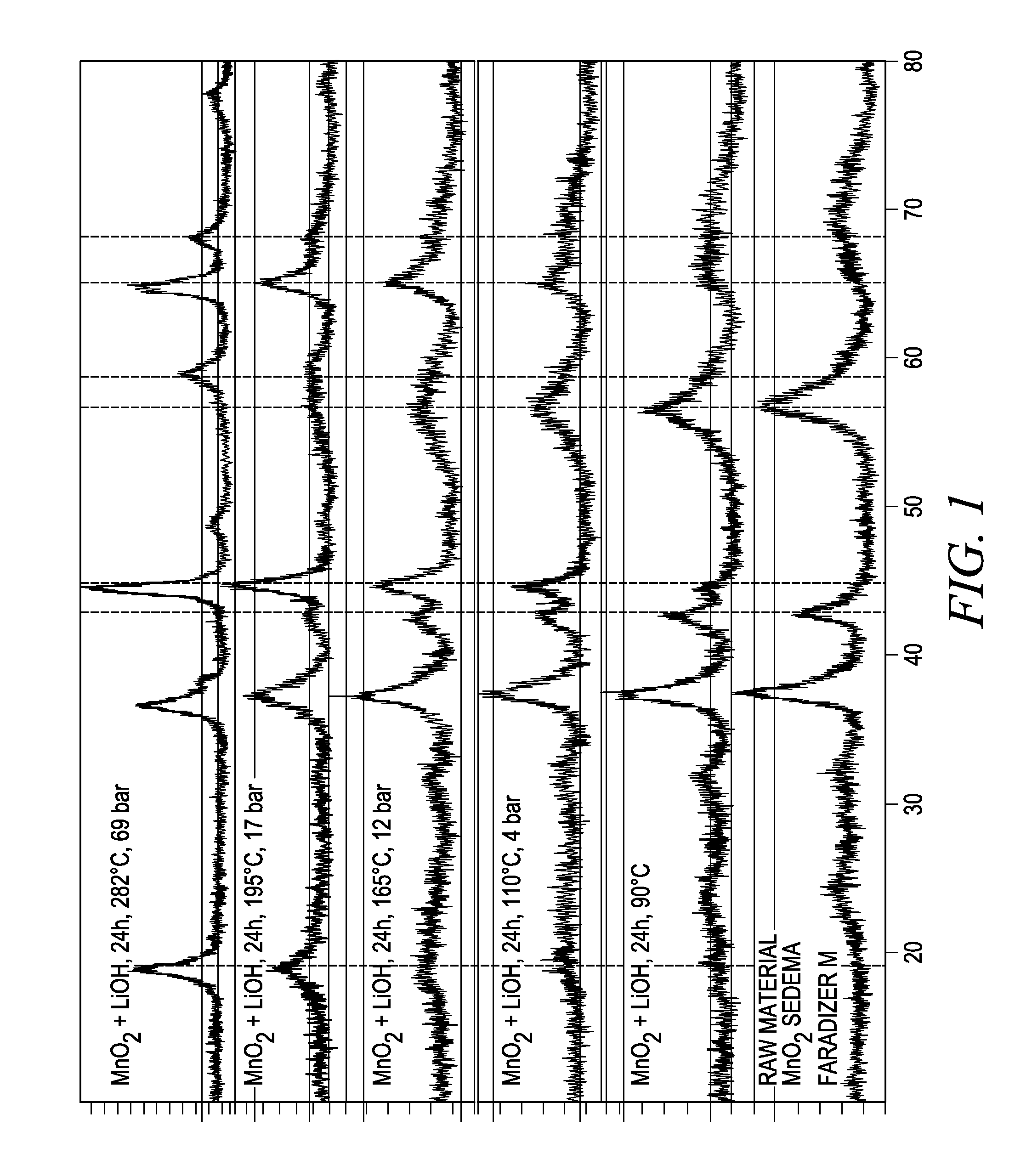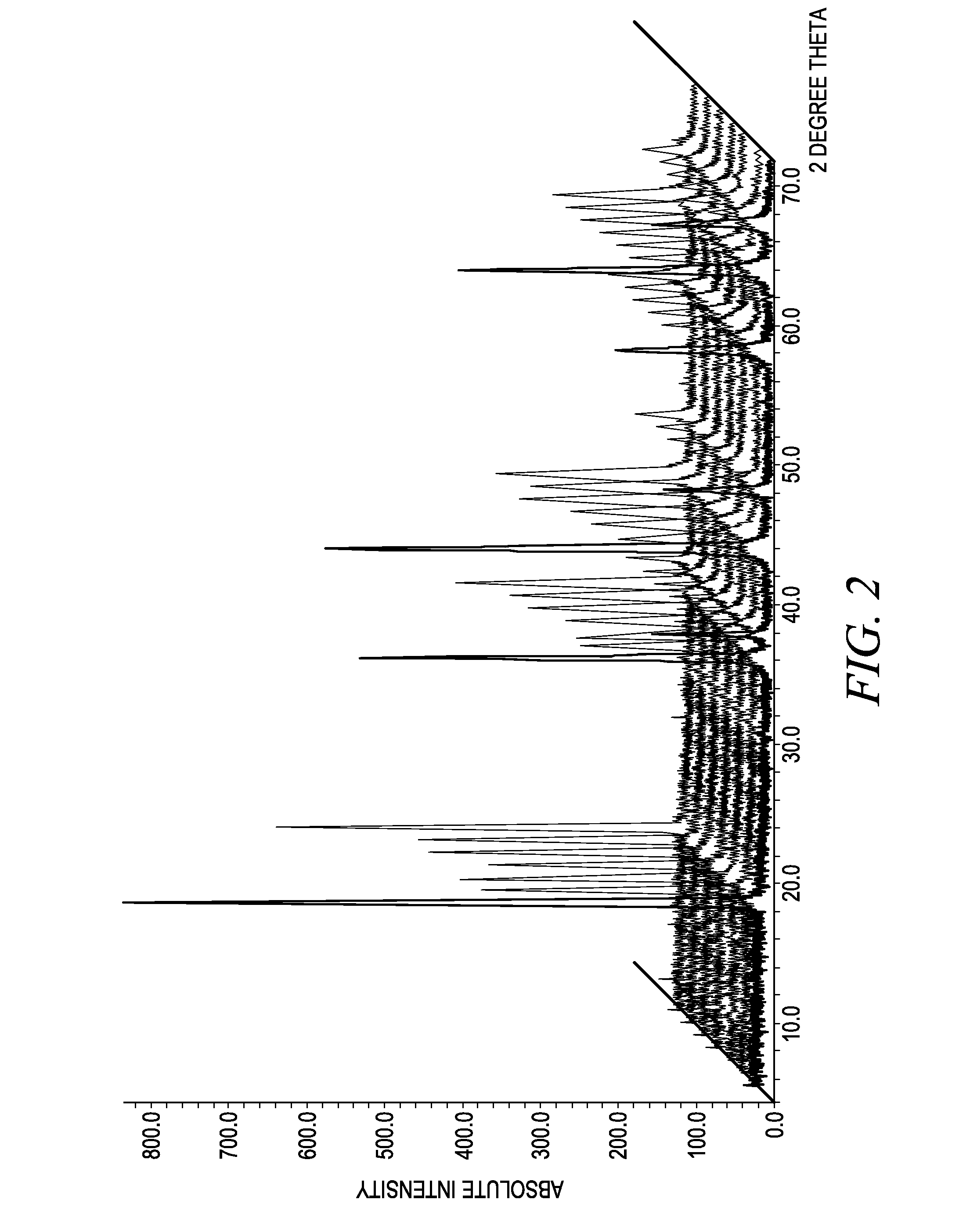Process for the preparation of lithium metal oxides involving fluidized bed techniques
a technology of lithium metal oxide and fluidized bed, which is applied in the field of lithium metal oxide preparation, can solve the problems of batch-to-batch inconsistencies, mixture may not have a homogeneous partial pressure distribution, and product mixture may not be very well crystallized
- Summary
- Abstract
- Description
- Claims
- Application Information
AI Technical Summary
Problems solved by technology
Method used
Image
Examples
example 1
Benchmark
[0048]To determine a benchmark capacity of samples that were tested in batteries, a slurry of about 82% lithium metal oxide, about 4% Super P carbon black Li, about 4% graphite KS6 and about 10% PVDF Solef 21216 in acetone was first made. The slurry was then cast onto aluminum foil at a thickness of about 25 microns and the solvent was evaporated. The coated foil was cut into round-shaped pieces having a diameter of about 18 mm and dried at about 90° C. in an about 1 mbar vacuum (an 80 micron thick coating is equivalent to about 20 mg lithium metal oxide per disc).
[0049]A coin cell type battery was assembled using the prepared discs as a cathode and lithium foil as an anode. The cathode and anode were separated by a glass cloth separator. The cell was then filled with electrolyte (1 mol / L lithiumhexafluorophosphate in a blend of 1:1 ethylene carbonate / dimethyl carbonate by volume). The battery was charged to about 4.3 V at a C-rate of about one third and a discharge of abou...
example 2
Preparation of Lithium-Manganese Oxide
[0050]About 4 liters of water was introduced into a 10 liter autoclave. Subsequently, about 1114 grams lithium hydroxide and about 4000 grams of manganese dioxide were added into the autoclave to form a mixture. While stirring, the mixture was heated to an internal temperature of about 165° C. and kept at this temperature for about 18 hours under autogenous pressure. The solid phase was then separated from the aqueous phase by filtration and washed with about 2 liters of water.
[0051]The solid lithium-manganese oxide formed was used in the Examples below.
example 3
[0052]A batch of 8,698 kg of lithium-manganese oxide was introduced into a fluidized bed reactor. The reactor was closed and put into a fluidized bed oven preheated to about 143° C. The starting fluidization air flow was set to about 5.2 Nm3 / h of air, corresponding to a gas velocity of about 9 centimeters per second (cm / s). The fluidizing gas flow was adjusted about every 100-150° C. to maintain the gas velocity. The target temperature was determined to be about 770° C. To reach the target temperature, the reactor was initially set to about 750° C. and was then adjusted to between about 770° C. and about 775° C.
[0053]A Blow-Back cleaning system was set to pulse about every 30 seconds in each zone and subsequently changed to about every 60 seconds. The target temperature was achieved and a hold time of about 5 hours was started. A sample was taken about every hour. After each hour elapsed, the process was stopped and the reactor pulled from the oven and allowed to cool down. The flui...
PUM
| Property | Measurement | Unit |
|---|---|---|
| temperature | aaaaa | aaaaa |
| time | aaaaa | aaaaa |
| temperature | aaaaa | aaaaa |
Abstract
Description
Claims
Application Information
 Login to View More
Login to View More - R&D
- Intellectual Property
- Life Sciences
- Materials
- Tech Scout
- Unparalleled Data Quality
- Higher Quality Content
- 60% Fewer Hallucinations
Browse by: Latest US Patents, China's latest patents, Technical Efficacy Thesaurus, Application Domain, Technology Topic, Popular Technical Reports.
© 2025 PatSnap. All rights reserved.Legal|Privacy policy|Modern Slavery Act Transparency Statement|Sitemap|About US| Contact US: help@patsnap.com


